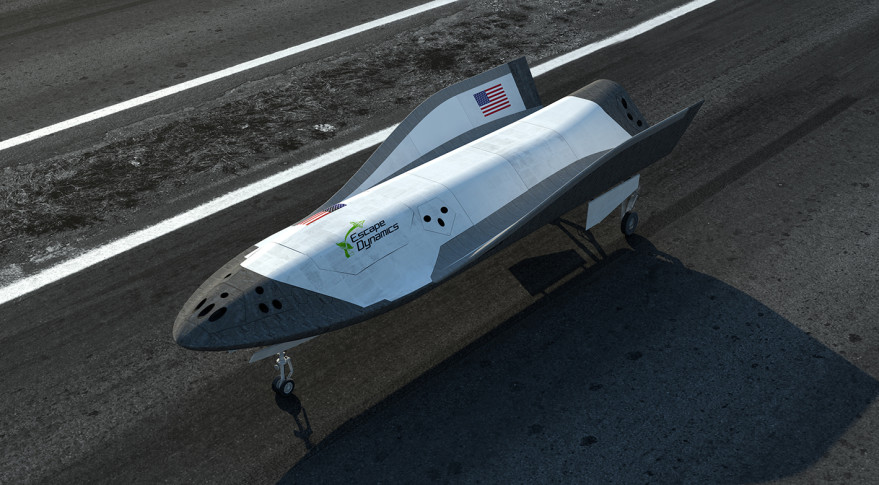Startup Makes Progress in Beamed Propulsion for Reusable Launch Vehicles

SAN JOSE, Calif. — A small Colorado company has successfully tested a new type of propulsion technology that it believes could eventually enable low-cost, single-stage-to-orbit launch vehicles.
Broomfield, Colorado-based Escape Dynamics announced July 17 it carried out a small-scale test in the laboratory of its beamed microwave thruster. In that test, the company beamed microwave energy to a thruster, heating helium propellant and generating a small amount of thrust.
"Using microwave-powered propulsion is really what we think is the next giant leap in space access," said company president Laetitia Garriott de Cayeux during a presentation at the NewSpace 2015 conference here July 17. [Superfast Spacecraft Propulsion Concepts (Images)]
Unlike conventional chemical propulsion, where the energy is stored in the propellants themselves, beamed microwave propulsion stores the energy on the ground and transmits it to the launch vehicle using microwaves. A heat exchanger on the launch vehicle converts the microwaves into thermal energy to heat up a propellant, such as hydrogen and helium, which is then expelled to generate thrust.
That concept reduces the complexity of the launch vehicle. "It's essentially a tank, a turbopump, a heat exchanger, and an aerospike nozzle," Garriott said. "It's overall very simple compared to a chemical rocket."
The beamed microwave propulsion technology is also more efficient than chemical propulsion. The most energetic propellants in common use today, liquid oxygen and liquid hydrogen, have a specific impulse — a measure of rocket engine efficiency — of about 450 seconds. Garriott said the beamed energy thruster tested in her company's lab had a specific impulse of more than 500 seconds, and could achieve up to 750 seconds by using hydrogen instead of helium.
That increases efficiency and simplicity reduces the fraction of the launch vehicle's mass devoted to propellant to as low as 70 percent. "This means you have a full 30 percent to allocate to payload and structure," she said. "This is plenty in a world where chemical rockets have only 10 percent."
Get the Space.com Newsletter
Breaking space news, the latest updates on rocket launches, skywatching events and more!
That increased mass fraction makes a reusable launch vehicle both technically and economically feasible, she argued. "We think that the future is reusable, single-stage-to-orbit spaceplanes," she said. "The reason that microwave-powered launch is the next giant leap in spaceflight is because it has the capability to produce a specific impulse above the threshold needed for single-stage-to-orbit operations."
Escape Dynamics' long-term goal is to use beamed energy propulsion for a reusable launch system. A concept Garriott presented at the conference involved a single-stage vehicle based on lifting body designs and two arrays of microwave transmitters, each producing about 400 megawatts of power. One array, located near the launch pad, would boost the vehicle off the pad vertically. A second array, located about 200 kilometers away, would then accelerate the vehicle into orbit.
The lifting body, once in orbit, would release its payload and, after a single orbit, re-enter and glide to a runway landing for reuse. Each vehicle could place up to 200 kilograms into low Earth orbit at a "hundred-fold" decrease from current launch costs, she said, without quoting a specific price. The company has not disclosed the overall development cost of the system, or how much the company has raised to date.
Such a system takes advantage of technological advancements beyond the beamed microwave propulsion system itself. Garriott cited advances in technology to store power and discharge it quickly, some of it developed in support of the Large Hadron Collider, and in composite materials for use in the heat exchanger.
Garriott said the company is still years away from developing a reusable launch vehicle with this technology. Within the next few years, Escape Dynamics plans to carry out more tests, switching from helium to hydrogen propellants and scaling up the thrusters, before starting work on an orbital launch system. "We are three years into an eight-year plan," she said.
This story was provided by SpaceNews, dedicated to covering all aspects of the space industry.
Join our Space Forums to keep talking space on the latest missions, night sky and more! And if you have a news tip, correction or comment, let us know at: community@space.com.

Jeff Foust is a Senior Staff Writer at SpaceNews, a space industry news magazine and website, where he writes about space policy, commercial spaceflight and other aerospace industry topics. Jeff has a Ph.D. in planetary sciences from the Massachusetts Institute of Technology and earned a bachelor's degree in geophysics and planetary science from the California Institute of Technology. You can see Jeff's latest projects by following him on Twitter.










